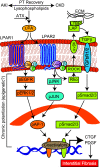Cooperative activation of divergent pathways by LPAR1 and LPAR2 receptors in fibrotic signaling
- PMID: 33491561
- PMCID: PMC7988805
- DOI: 10.1152/ajprenal.00685.2020
Cooperative activation of divergent pathways by LPAR1 and LPAR2 receptors in fibrotic signaling
Keywords: acute kidney injury; chronic kidney disease; fibrosis; lysophosphatidic acid; tubulointerstitial fibrosis.
Conflict of interest statement
No conflicts of interest, financial or otherwise, are declared by the authors.
Figures

Comment on
-
Proximal tubule LPA1 and LPA2 receptors use divergent signaling pathways to additively increase profibrotic cytokine secretion.Am J Physiol Renal Physiol. 2021 Mar 1;320(3):F359-F374. doi: 10.1152/ajprenal.00494.2020. Epub 2021 Jan 11. Am J Physiol Renal Physiol. 2021. PMID: 33427061 Free PMC article.
References
Publication types
MeSH terms
Substances
Grants and funding
- DK 065073/HHS | NIH | National Institute of Diabetes and Digestive and Kidney Diseases (NIDDK)
- R01 DK081705/DK/NIDDK NIH HHS/United States
- DK 081705/HHS | NIH | National Institute of Diabetes and Digestive and Kidney Diseases (NIDDK)
- R01 DK065073/DK/NIDDK NIH HHS/United States
- R01 HL106089/HL/NHLBI NIH HHS/United States
LinkOut - more resources
Full Text Sources
Other Literature Sources

